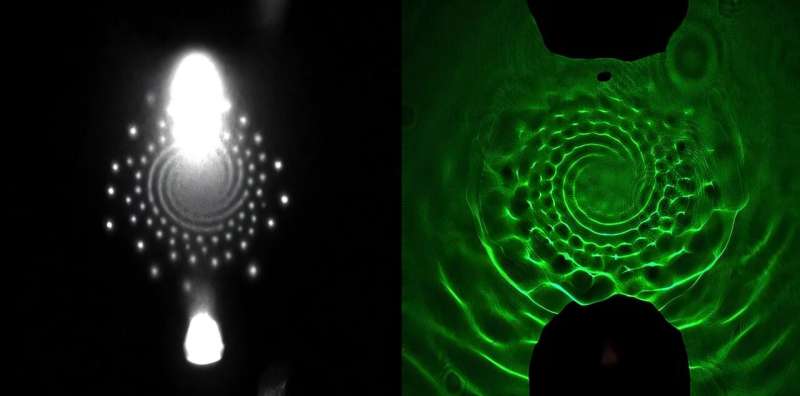
Recent research from the University of Michigan has unveiled a promising method for eliminating PFAS, commonly referred to as “forever chemicals,” from contaminated water. This innovative approach harnesses intricate plasma patterns that self-organize when exposed to water, potentially enhancing the efficiency of water treatment systems.
Under specific conditions, plasma can form complex structures that increase the surface area available for interactions with water. These formations resemble stars or gears, effectively expanding the contact area and improving the decontamination process. The research team successfully captured the first images of the water surface beneath these self-organizing plasma patterns. The images revealed that the plasma exerts an electrical force on the water, distorting its surface and generating surface waves.
The study, published in Plasma Sources Science and Technology, indicates that the shape and size of these waves are influenced by factors such as the rate of gas heating and the electrical properties of water. By manipulating these elements, researchers aim to create larger plasma surfaces, enabling the treatment of greater volumes of water simultaneously.
Understanding PFAS and Its Risks
PFAS compounds have been widely used in products for their heat and stain-resistant properties, including firefighting foams and non-stick cookware. Unfortunately, the strong carbon-fluorine bonds that give PFAS these beneficial characteristics also render them highly resistant to degradation. As PFAS infiltrates groundwater and surface water, it can be absorbed by crops and animals, posing significant health risks, including increased cancer risk and endocrine disruption.
Existing water treatment methods often fall short in breaking down PFAS. The study highlights that plasma technology could be a viable alternative. The plasma used in this process is an activated gas created from regular air at atmospheric pressure, consisting of energetic electrons, ions, and other excited species. Notably, nonthermal plasmas produced through rapid high-voltage pulses do not heat the water, making them suitable for delicate environments, including biological tissues.
John Foster, a professor of nuclear engineering and radiological sciences at the university and senior author of the study, emphasized the effectiveness of cold plasma in eliminating various contaminants. “Laboratory demonstrations show cold plasma can get rid of a lot of contaminants in water, removing them almost completely. It opens up a new opportunity to treat these legacy chemicals,” Foster stated.
Advances in Plasma Technology
The unique behavior of plasma creates what researchers describe as “entropy-reversing patterns.” Unlike typical dissipative waves, these patterns become increasingly complex as they spread, resulting in a larger contact area with the water. Foster explained, “These processes are governed by non-equilibrium thermodynamics, allowing for self-organization that enhances the treatment capability.”
The research team used a specialized high-speed camera setup to study the plasma-water interactions occurring over mere microseconds. By synchronizing the camera with plasma jet pulses, they captured how the plasma deforms the water surface, confirming that the plasma pattern drives the water’s surface waves.
Zimu Yang, a doctoral graduate and first author of the study, noted a moment of inspiration that led to the discovery of the textured water surface beneath the plasma. “The deformed liquid surface had always been there, but I suddenly realized while looking at the liquid surface at a certain angle,” Yang remarked.
The implications of this research are significant. By controlling the patterns and scaling the technology, plasma methods could be integrated into existing water treatment facilities to efficiently eliminate contaminants like PFAS on a larger scale.
In summary, the findings from the University of Michigan present an exciting development in the fight against PFAS contamination. As researchers continue to refine this technology, it holds the potential to revolutionize water treatment processes and safeguard public health against the dangers posed by these persistent chemicals.






